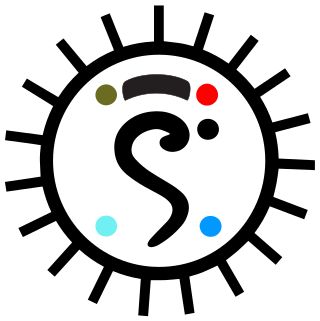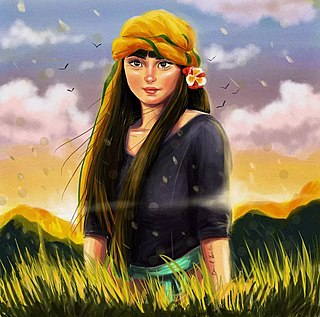
Pakhangba is a primordial deity, often represented in the form of a dragon, in Meitei mythology and Sanamahism, the indigenous religion of Manipur. He is depicted in the heraldry of Manipur kingdom, which originated in paphal, mythical illustrations of the deity. It is believed that the ancestor of one of the Meitei clans manifested himself as the Pakhangba.

Imoinu or Emoinu is a goddess associated with household, hearth, family, fireplace, kitchen, wealth, peace and prosperity in Meitei mythology and religion of Ancient Kangleipak. She is frequently associated with Leimarel Sidabi. She is regarded as one of the incarnations or representations of goddess Leimarel Sidabi.

Laininthou Sanamahee is the Supreme Guardian God of mankind and the supreme deity of the household in Meetei religion and mythology. He originated from the ancient kingdom of Kangleipak (Manipur). He is regarded as the most popular and significant divinity of Sanamahism. He is the brother of Pakhangba and Nongshaba. He is the eldest son of Creator God Saalailel Sitapa and Leimalel Sitapee, the protector of the Universe in Meetei mythology and philosophy and Mother Earth goddess Leimarel Sidabi.

Leimarel Sidabi or Leimalel Sitapi is a goddess in Sanamahism, the indigenous religion of Manipur. She is the highest female divinity in the Meitei pantheon. She is the goddess of earth, of nature and the household. She is revered as the mother of every living being in the universe.

Panthoibi, also known as Nongpok Leima, is a goddess associated with civilization, courage, fertility, handicraft, love, victory, warfare and wisdom in the mythology and religion of Ancient Kangleipak. She is a consort of the God Nongpok Ningthou. She is considered to be one of the divine incarnations of Leimarel Sidabi and is also identified as a form of Goddess Nongthang Leima. She is worshipped mainly by the Meitei people in Manipur, Assam, Tripura, Bangladesh and Myanmar.

Nongshaba is a lion god in Sanamahism and Meitei mythology. He is also regarded as a king of the gods. He is credited with producing light in the primordial universe and is regarded as the maker of the sun. He is worshipped by the people of both the Ningthouja clans as well as the Moirang clans. Nongshaba was worshipped by the people of Moirang clan as a lineage deity and regarded as the father of the god Thangching. He is the greatest of the Umang Lais but he made his only son Thangching the chief deity of Moirang.
The Hiyangthang Lairembi Temple is an ancient temple of Goddess Hiyangthang Lairembi of Meitei religion (Sanamahism). The sacred building is situated on the hilltop of Heibok Ching in the Hiyangthang, Manipur. Thousands of devotees thronged at the holy site during the festival time of Lai Haraoba of Sanamahism as well as Durga Puja of Hinduism.

Irai Leima is a goddess in Sanamahism, the indigenous religion of Manipur. She is the goddess and the divine female personification of water and aquatic life. She is the consort of Irai Ningthou. Both are regarded as the divine spirits of water bodies. She is also considered to be in charge of diseases.

In Meitei mythology and religion, Nongthang Leima is the goddess of seduction, thunder, and lightning. She was created by Atingkok to attract Haraba (Pakhangba). She mastered thunder and lightning in the chaos in the early world. She predicted the first rain. She limits the chaos and helps creation.

Nongpok Ningthou, also known as the Sovereign of the East or King of the East, is a deity in Sanamahism, the indigenous religion of Manipur. He is the ruling guardian deity of the eastern direction. Legend says Nongpok Ningthou and his consort Panthoibi were united in the Nongmaiching Ching mountains. Later, they were worshipped as the civilization giving deities in Meitei religion.

Kounu is a goddess in Meitei mythology and Sanamahism, the indigenous religion of Manipur. She is a consort of the god Koupalu. She is the guardian of the northern direction. Kounu has two homes. Her main home is on Mount Kounu. Her other home is in Mount Koubru, which is where her husband Koupalu (Koubru) lives. She is worshipped with Koubru as the deities of the Khullakpa. Kounu and Koubru ruled ancient Manipur for a very long time after the reign of King Ningthou Puthiba.

Khoriphaba is a God in Sanamahism, the indigenous religion of Manipur. He is the son of Sky God Salailen and the Goddess Konthoujam Tampha Lairembi. He came down from heaven to earth to search for his mother and then for a bride. He is best known for wrestling with Loyalakpa in the Lai Haraoba festival. He is also a Sagol Kangjei(polo)-playing God.

Loyalakpa is a God in Sanamahism, the indigenous religion of Manipur. He is best known for wrestling with Khoriphaba during the Lai Haraoba festival. He is the consort of goddess Thoudu Nungthel Leima. He is one of the ten kingly gods in Meitei religion.

Thongak Lairembi, is a divine female personification of the death who guards the door of the entrance to the underworld.

Market goddesses or merchant goddesses are the goddesses known for keeping different market shops in Meitei mythology and religion Sanamahism, the indigenous religion of Manipur. Different sources have different answers to how many shopkeeping goddesses there are. They are Cheng Leima, Chinga Leima, Heipok Leima, Hei Leima, Laa Leima, Phu Leima, Pishum Leima, Thangching Leima, Waisheng Leima, Waithou Leima and Waal Leima.

Nganu Leima is the goddess of ducks and waterfowl in Sanamahism, the indigenous religion of Manipur. She is a sister of goddesses Khunu Leima and Shapi Leima. Legend says that all three sisters married to the same mortal man.

The Lainingthou Sanamahi Temple Board (LSTB) is a temple development board of the Lainingthou Sanamahi Temple, Haying Khongban Uphong Yumpham, Imphal West district of Kangleipak (Meitei for 'Manipur'). It is dedicated not only to God Lainingthou Sanamahi and Goddess Leimarel Sidabi of Sanamahism, but also to the other ancient Meitei gods and goddesses of the traditional Meitei religion.

Women have significant roles in different elements of Meitei culture, including Meitei dances, Meitei festivals, Meitei folklore, Meitei folktales, Meitei literature, Meitei mythology, Meitei religion, etc.











